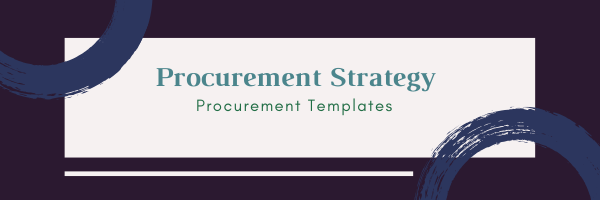A commercial function or Procurement department strategy should have the 4 P’s here following:
- Procurement Policy
- Procurement Strategy
- Procurement Procedures
- Procurement Documents
In this article, I will discuss No. 3 A procurement strategy. This allows an organisation to set out how the procurement function intends to deliver activity to achieve value for money and contribute towards for example the 5-year business plan.
Getting started
Writing a procurement strategy helps the procurement department to underpin the strategic plan and provides a strategic focus for the role of the procurement team. Though savings is a significant part of the procurement contribution the function should look beyond savings as being the only value that is on offer. The strategy should incorporate wider social economic and environmental aims and consider how these align with business needs and how procurement assistance can be translated into activities that will contribute and support the business.
Preparing a strategy shouldn’t be done in isolation because to deliver what you promise requires appropriate buy-in. It’s important that the procurement strategy takes in to account the views of different stakeholders who need to give their buy-in. By involving them they are more likely to support the strategy and provide feedback on areas that work well and areas that they are less likely to support. The stakeholder group will have different opinions, therefore, it’s important to take these into account, but procurement should also challenge and educate where appropriate.
Identify a senior responsible owner for the procurement strategy. Ideally, the procurement strategy should be supported by a senior member of staff with a Board level position. It is also important that the CEO supports the procurement strategy and make a formal note that the procurement policy is mandated. Getting the right support makes users accountable for their actions. Getting sign off at the right level sends out the message that there is commitment at the highest level from top down.
The strategy should set out what procurement will deliver. Examples might include:
- Value for Money
- Transparency of Procurement Process
- Equal treatment
- Pre-Market Engagement
- Route to Market Options
- Accountability
- Sustainability
- Regulated requirements such as Minimum wage versus Living Wage
- Use of framework agreements
Communications can be for pre-launch of strategy and post-launch. Consultation and engagement with stakeholders are useful to understand areas of business requirements and competing views and needs are taken into account.
If the organisation is a public sector contracting authority it is responsible for ensuring its procurement activity complies with the relevant legislation. It is useful to review the procurement strategy annually to check that it remains appropriate each financial year. If the business direction has changed the procurement strategy should be updated to allow for new alignment with the organisation objectives.
Writing the Department/Functional Procurement Strategy
Example Headings:
- Contents Table
- Introduction/ Executive Summary
- Procurement Vision or Mission Statement
- Strategy, Rational & Context
- Strategic Aims/Key Objectives
- Financial information such as spend analysis
- Recommendations/ Tender Pipeline
- Implementation, Monitoring & Reporting
- Key Team & Ownership of Key Areas
- Policies, Tools & Procedures
- Appendices
- Glossary
Check out the category management pages or read more at CIPS Procurement Strategy



